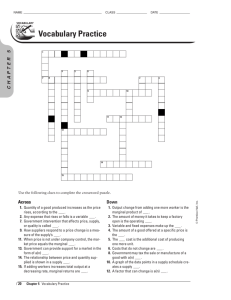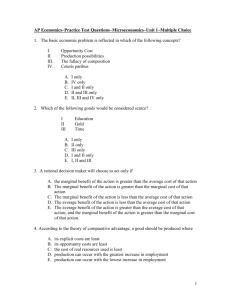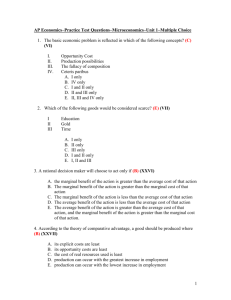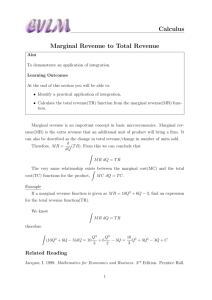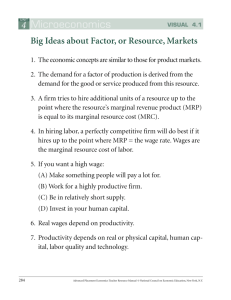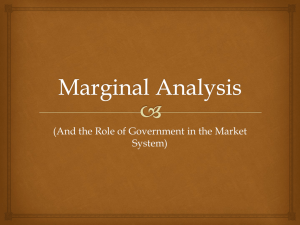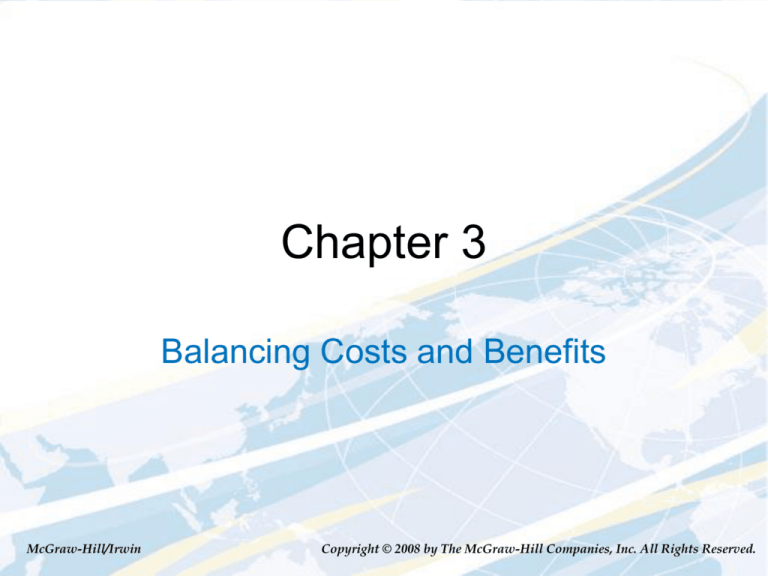
Chapter 3
Balancing Costs and Benefits
McGraw-Hill/Irwin
Copyright © 2008 by The McGraw-Hill Companies, Inc. All Rights Reserved.
Main Topics
Maximizing benefits less costs
Thinking on the margin
Sunk costs and decision-making
3-2
Maximizing Net Benefit
Net benefit: total benefit minus total cost
Total cost must include opportunity cost
Opportunity cost: the cost associated
with foregoing the opportunity to employ
a resource in its best alternative use
Right decision is the choice with the
greatest difference between total benefit
and total cost
3-3
Car Repair Example:
Benefit Schedule
Mechanic’s time is
available in one-hour
increments
Maximum repair time
is 6 hours
The more time the car
is repaired, the more
it is worth
Table 3.1: Benefits of Repairing Your
Car
Repair Time
(Hours)
Total Benefit
($)
0
0
1
615
2
1150
3
1600
4
1975
5
2270
6
2485
3-4
Car Repair Example:
Cost Schedule
Table 3.2: Costs of Repairing Your Car
Repair
Time
(Hours)
Cost of Mechanic and
Parts
($)
Lost Wages from
Pizza Delivery Job
($)
Total
Cost
($)
0
0
0
0
1
140
10
150
2
355
25
380
3
645
45
690
4
1005
75
1080
5
1440
110
1550
6
1950
150
2100
3-5
Car Repair Example:
Maximizing Net Benefit
How should you decide how many hours
is the “right” number to have your car
repaired?
Recall that every hour in the shop will
bring both benefits and costs
Choose the number of hours where
benefits exceed costs by the greatest
amount
3-6
Car Repair Example:
The Right Decision
Table 3.3: Total Benefit and Total Cost of
Repairing Your Car
Repair Time
(Hours)
Total Benefit
($)
Total Cost
($)
0
0
0
1
615
150
2
1150
380
3
1600
690
4
1975
1080
5
2270
1550
6
2485
2100
Net Benefit
($)
3-7
Car Repair Example:
The Right Decision
Table 3.3: Total Benefit and Total Cost of
Repairing Your Car
Repair Time
(Hours)
Total Benefit
($)
Total Cost
($)
Net Benefit
($)
0
0
0
0
1
615
150
465
2
1150
380
770
3
1600
690
910
4
1975
1080
895
5
2270
1550
720
6
2485
2100
385
3-8
Car Repair Example:
The Right Decision
Table 3.3: Total Benefit and Total Cost of
Repairing Your Car
Best
Choice
Repair Time
(Hours)
Total Benefit
($)
Total Cost
($)
Net Benefit
($)
0
0
0
0
1
615
150
465
2
1150
380
770
3
1600
690
910
4
1975
1080
895
5
2270
1550
720
6
2485
2100
385
3-9
Car Repair Example:
Graphical Approach
(Figure 3.1)
Data from Table 3.3 are
shown in this graph
Costs are in red; benefits
are in blue
The best choice is where
benefits > costs and the
distance between them
is maximized
This is at 3 hours, net
benefit = $910
Total
Benefit,
Total
Cost
($)
2400
2000
710
1600
910
1200
800
400
465
1
2
3
4
5
6
Repair
Hours
Best Choice
3-10
Maximizing Net Benefit:
Finely Divisible Actions
Many decisions involve actions that are
more finely divisible
E.g. mechanic’s time available by the
minute
In these cases can use benefit and cost
curves rather than points or a schedule
to make the best decision
Underlying principle is the same:
maximize net benefit
3-11
Sample Problem 1
Identifying costs
What are the costs of buying a concert ticket
if you have to wait in line for 2 hrs?
Ticket master
What is the cost of watching a movie for two
hours?
Car Repair Example:
Finely Divisible Benefit
(a): Total Benefit
Horizontal axis
measures hours of
mechanic’s time
Vertical axis
measures in dollars
the total increase in
your car’s value
B(H)=654H-40H2
Total Benefit
($)
B
2270
1602
614
0
1
2
3
4
5
6
Hours (H)
3-13
Car Repair Example:
Finely Divisible Cost
(b): Total Cost
Vertical axis
measures total cost
in dollars
Includes opportunity
cost
C(H)=110H+40H2
Total Cost
($)
C
1550
690
150
0
1
2
3
4
5
6
Hours (H)
3-14
Car Repair Example:
Finely Divisible Net Benefit
Best choice is 3.4
hours of repair,
maximizes net
benefit
Net benefit with finely
divisible choices is
greater than in
previous example;
more flexibility allows
you to do better
(c): Total Benefit versus Total
Cost
Total
Benefit
Total
Cost
($)
B
1761.20
924.80
C
836.40
0
1
2
3
Hours
(H)
4
5
6
3.4
3-15
Net Benefit Curve
(Figure 3.3)
Can also graph the
net benefit curve
Vertical axis shows
B-C, net benefit
Best choice is the
number of hours that
corresponds to the
highest point on the
curve, 3.4 hours
Net
Benefit
($)
924.80
B–C
0
1
2
3
Hours (H)
4
5
6
3.4
3-16
Sample Problem 2 (3.1)
Suppose that the cost of hiring your
mechanic (including the cost of parts)
is $200 an hour up to four hours (she
charges for her time in one-hour
increments). Your benefits and other
costs are the same as in tables 3.1
and 3.2. Construct a table like Table
3.3. What is your best choice?
Thinking on the Margin
Thinking like an economist
Another approach to maximizing net
benefits
Capture the way that benefits and costs
change as the level of activity changes
just a little bit
For any action choice X, the marginal units
are the last DX units, where DX is the
smallest amount you can add or subtract
3-18
Marginal Cost
The marginal cost of an action at an activity
level of X units is equal to the extra cost
incurred due to the marginal units, divided by
the number of marginal units
DC C ( X ) C ( X DX )
MC
DX
DX
3-19
Car Repair Example:
Marginal Cost
Marginal cost measures the additional
cost incurred from the marginal units
(DH) of repair time
If C(H) is the total cost of H hour of repair
work, the extra cost of the last DH hours
is DC = C(H) – C(H-DH)
To find marginal cost, divide this extra
cost by the number of extra hours of
repair time, DH
3-20
Car Repair Example:
Marginal Cost
So the marginal cost of an additional hour of
repair time is:
DC C ( H ) C ( H DH )
MC
DH
DH
Using the data from Table 3.2, if H= 3, we see:
C (3) C (2)
MC
690 380 310
1
3-21
Car Repair Example:
Marginal Cost Schedule
Table 3.5: Total Cost and Marginal
Cost of Repairing Your Car
Repair
Time
(Hours)
Total Cost
($)
Marginal Cost (MC)
($/hour)
0
0
-
1
150
150
2
380
230
3
690
310
4
1080
390
5
1550
470
6
2100
550
3-22
Marginal Benefit
The marginal benefit of an action at an
activity level of X units is equal to the extra
benefit produced due to the marginal units,
divided by the number of marginal units
DB B( X ) B( X DX )
MB
DX
DX
3-23
Car Repair Example:
Marginal Benefit
Marginal benefit measures the additional
benefit gained from the marginal units
(DH) of repair time
This parallels the definition and formula
for marginal cost
3-24
Car Repair Example:
Marginal Benefit
The marginal benefit of an additional hour of
repair time is:
DB B ( H ) B ( H DH )
MC
DH
DH
Using the data from Table 3.1, if H= 3, we see:
B (3) B(3 1)
MC
1600 1150 450
1
3-25
Car Repair Example:
Marginal Benefit Schedule
Table 3.6: Total Benefit and Marginal Benefit
of Repairing Your Car
Repair Time
(Hours)
Total Benefit
($)
Marginal Benefit (MB)
($/hour)
0
0
-
1
615
615
2
1150
535
3
1600
450
4
1975
375
5
2270
295
6
2485
215
3-26
Marginal Analysis and Best
Choice
Comparing marginal benefits and
marginal costs can show whether an
increase or decrease in a level of an
activity raises or lowers the net benefit
Increase level if MB of doing so is greater
than MC; if MC of last increase was
greater than MB, decrease level
At the best choice, a small change in
activity level can’t increase the net
benefit
3-27
Marginal Analysis and Best
Choice
Table 3.7: Marginal Benefit and Marginal
Cost of Repairing Your Car
Best
Choice
Repair
Time
(Hours)
Marginal
Benefit (MB)
($/hour)
Marginal
Cost (MC)
($/hour)
0
-
-
1
615
>
150
2
535
>
230
3
450
>
310
4
375
<
390
5
295
<
470
6
215
<
550
3-28
Marginal Analysis with
Finely Divisible Actions
Can conduct the same analysis if choices are
finely divisible by using marginal benefit and
marginal cost curves
Derive marginal benefit and marginal cost from
total benefit and total cost curves
Marginal benefit at H hours of repair time is
equal to the slope of the line drawn tangent to
the total benefit function at point
Usually called simply the “slope of the total
benefit curve” at point D
3-29
Car Repair Example:
Finely Divisible Marginal Benefit
Let DH' = the smallest possible change in hours
of car repair
Adding the last DH‘ of repairs increases total
benefit from point F to point D in Figure 3.4 (on
the next slide), this equal to:
DB B( H ) B( H DH )
Recall that marginal benefit is DB' /DH'
Since the vertical axis measures hours of work
and the horizontal axis measures total benefit,
then marginal benefit equals “rise” over “run”
between points F and D.
3-30
Relationship between Total
Benefit and Marginal Benefit
(Figure 3.4)
Total
Benefit
($)
Slope = MB
D
B( H )
Slope = MB = DB' / DH'
DB' '
E
B( H DH' ' )
DB'
B( H DH' )
F
H DH'
Slope
= MB = DB' ' / DH' '
H DH' '
H
Hours (H)
DH' '
DH'
3-31
Relationship between Total
Benefit and Marginal Benefit
Tangents to the total benefit function at
three different numbers of hours (H = 1,
H = 3, H = 5)
Slope of each tangent equals the
marginal benefit at each number of hours
Figure (b) shows the MB curve: note how
the MB varies with the number of hours
Marginal benefit curve is described by
the function MB(H)= 654-80H
3-32
Relationship between Total
Benefit and Marginal Benefit
(Figure 3.5)
(b): Marginal Benefit
(a): Total Benefit
Slope = MB = 254
Total
Benefit ($)
Marginal Benefit
($/hour)
Slope = MB = 414
654
2270
B
574
Slope = MB = 574
1602
414
MB
254
614
0
1
2
3
Hours (H)
4
5
6
0
1
2
3
4
5
6
Hours (H)
3-33
Relationship between Total Cost
and Marginal Cost
Parallels relationship between total benefit curve
and marginal benefit
When actions are finely divisible, the marginal
cost when choosing action X is equal to the
slope of the total cost curve at X
3-34
Relationship between Total Cost
and Marginal Cost
Tangents to the total cost curve at three
different numbers of hours (H = 1, H = 3,
H = 5)
Slope of each tangent equals the
marginal cost at each number of hours
Figure (b) shows the MC curve: note how
the MC varies with the number of hours
Marginal cost curve is described by the
function MC(H)= 110+80H
3-35
Relationship between Total Cost
and Marginal Cost
(Figure 3.6)
(a): Total Cost
(b): Marginal Cost
Marginal Cost
($/hour)
Total Cost
($)
C
MC
510
1550
350
Slope = MC = 510
Slope = MC = 190
690
190
110
Slope = MC = 350
150
0
1
2
3
Hours (H)
4
5
6
0
1
2
3
4
5
6
Hours (H)
3-36
Marginal Benefit Equals Marginal
Cost at a Best Choice
At the best choice of 3.4 hours, the No
Marginal Improvement Principle holds so
MB = MC
At any number of hours below 3.4, MB >
MC, so a small increase in repair time will
improve the net benefit
At any number of hours above 3.4, MC >
MB, so that a small decrease in repair
time will improve net benefit
3-37
Marginal Benefit Equals Marginal
Cost at a Best Choice (Figure 3.7)
Marginal
Benefit,
Marginal
Cost
($/hour)
654
MC
382
MB
110
0
1
2
Hours (H)
3
4
5
6
3.4
3-38
Slopes of Total Benefit and Total
Cost Curves at the Best Choice
MC = MB at the best choice of 3.4 hours
of repair
Therefore, the slopes of the total benefit
and total cost curves must be equal at
this point
Tangents to the total benefit and total
cost curves show this relationship
3-39
Slope of Total Benefit and Total
Cost Curves
(Figure 3.8)
Total
Benefit
Total
Cost
($)
B
924.80
0
1
2
3
Hours (H)
4
C
5
6
3.4
3-40
Sample Problem 3 (3.8)
Suppose you can hire your mechanic for
up to six hours. The total benefit and total
cost functions are B(H)= 400H1/2 and
C(H) = 100H. The corresponding
formulas for marginal benefit and
marginal cost are MB(H) = 200/H1/2 and
MC(H) = 100. What is your best choice?
Sunk Costs and Decision Making
A sunk cost is a cost that the decision
maker has already incurred, or
A cost that is unavoidable regardless of
what the decision maker does.
Sunk costs affect the total cost of a
decision
Sunk costs do not affect marginal costs
So sunk costs do not affect the best
choice
3-42
Car Repair Example: Best Choice
with a Sunk Cost
Figure 3.9 shows a cost-benefit
comparison for two possible cost
functions with sunk fixed costs: $500 and
$1100.
In both cases, the best choice is H = 3.4:
the level of sunk costs has no effect on
the best choice
Notice that the slopes of the two total
cost curves, and thus the marginal costs,
are the same
3-43
Best Choice with a Sunk Cost
(Figure 3.9)
C´
Total
Benefit,
Total
Cost
($)
B
-175.20
C
424.80
1100
500
0
1
2
3
Hours (H)
4
5
6
3.4
3-44
Sample Problem 4
Let’s say you run a bakery. If you are
month-to-month on your lease, is your
next month’s rent a sunk cost? What if
you are currently in the middle of a oneyear lease?
It will cost you $5,000 to purchase a new
oven. Is this a sunk cost?

